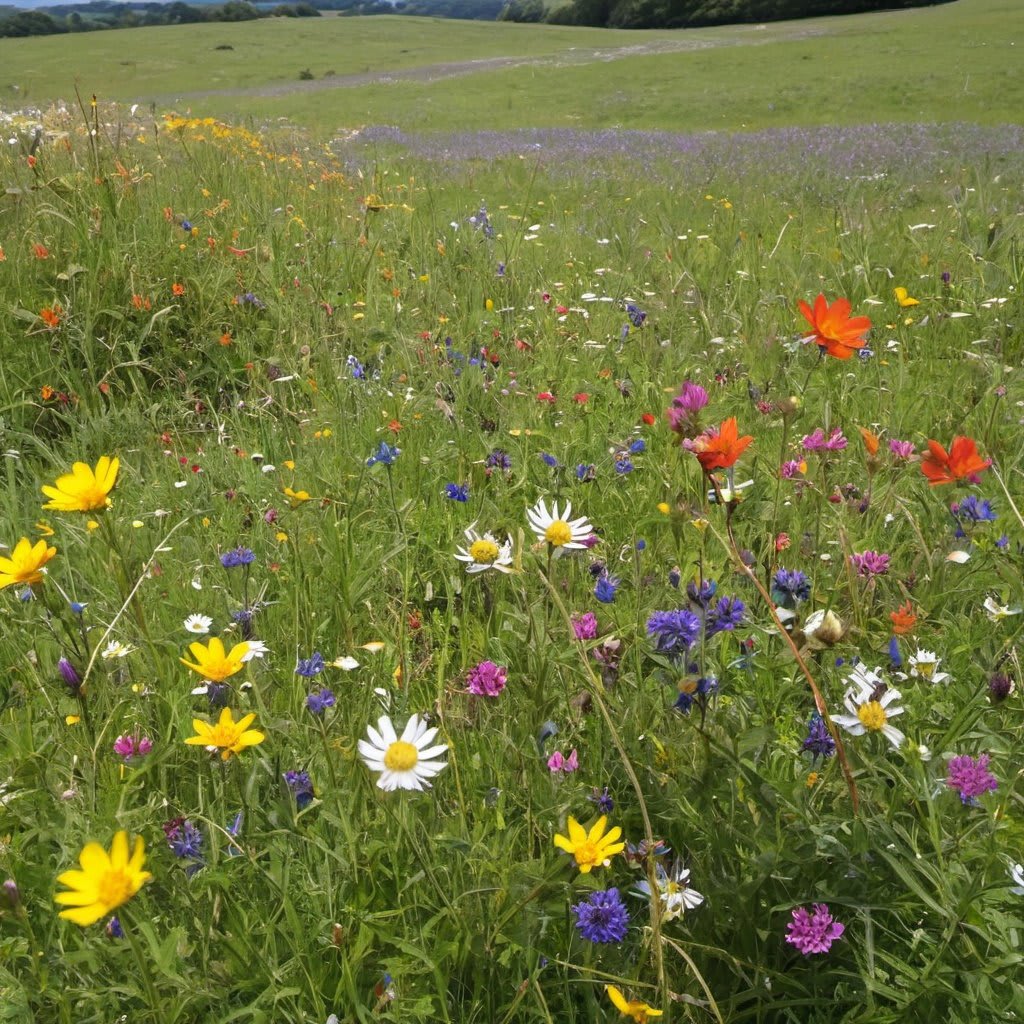The Importance of Wildflower Meadows
Sustaining Biodiversity and Ecosystem Health

Wildflower meadows, with their vibrant hues and delicate blooms, are not just a picturesque sight but also vital ecosystems teeming with life. These biodiverse habitats play a crucial role in sustaining both plant and animal species, promoting pollination, enhancing soil health, and contributing to the overall health of the environment. In this article, we'll explore the importance of wildflower meadows and why their preservation is essential for biodiversity and ecosystem resilience.
Biodiversity Hotspots:
Wildflower meadows are biodiversity hotspots, supporting a rich variety of plant species, including native wildflowers, grasses, and herbs. Unlike monoculture grasslands or agricultural fields, which are often dominated by a single species, wildflower meadows boast a diverse mix of plant life, each playing a unique role in the ecosystem. This diversity provides habitat and food sources for a wide range of insects, birds, and mammals, contributing to the overall health and resilience of the ecosystem.
Pollinator Habitat:
Wildflower meadows are essential habitats for pollinators such as bees, butterflies, and other insects. The nectar and pollen-rich flowers found in these meadows provide valuable food sources for pollinators throughout the growing season. As pollinators move from flower to flower in search of nectar, they facilitate the process of pollination, essential for the reproduction of many flowering plants, including agricultural crops. By providing a diverse and abundant supply of nectar and pollen, wildflower meadows support healthy pollinator populations and contribute to the pollination of crops and wild plants alike.
Soil Health and Nutrient Cycling:
The deep root systems of wildflowers and grasses found in meadows play a vital role in enhancing soil health and promoting nutrient cycling. These extensive root networks help to anchor the soil, preventing erosion and improving its structure and fertility. As plants grow and decay, organic matter accumulates, enriching the soil with essential nutrients. This nutrient-rich soil supports the growth of diverse plant communities, creating a self-sustaining ecosystem that thrives without the need for chemical fertilizers or pesticides.
Carbon Sequestration and Climate Regulation:
Wildflower meadows contribute to climate regulation by sequestering carbon dioxide from the atmosphere and storing it in the soil and plant biomass. The deep roots of wildflowers and grasses store carbon underground, helping to mitigate the effects of climate change by reducing greenhouse gas emissions. Additionally, the dense vegetation of wildflower meadows provides shade and helps to cool the surrounding environment, reducing the urban heat island effect and mitigating the impacts of rising temperatures in urban areas.
Natural Pest Control:
The diverse array of plant species found in wildflower meadows supports a healthy population of beneficial insects, including predatory beetles, parasitic wasps, and spiders, which act as natural pest controllers. These beneficial insects prey on harmful pests such as aphids, caterpillars, and mites, helping to keep pest populations in check without the need for chemical pesticides. By promoting natural pest control mechanisms, wildflower meadows contribute to sustainable agriculture and reduce the reliance on synthetic pesticides, which can have harmful effects on human health and the environment.
Cultural and Recreational Value:
Beyond their ecological importance, wildflower meadows hold cultural and recreational value for communities around the world. These natural landscapes inspire artists, poets, and nature enthusiasts alike, serving as sources of inspiration and beauty. Wildflower meadows provide opportunities for outdoor recreation such as hiking, photography, and birdwatching, allowing people to connect with nature and experience its wonders firsthand. Additionally, wildflower meadows contribute to the aesthetic appeal of landscapes, enhancing the visual quality of urban and rural areas alike.
Habitat for Endangered Species:
Many species of wildlife, including birds, mammals, and insects, rely on wildflower meadows for habitat and food sources. In areas where natural habitats have been lost or degraded, wildflower meadows can provide critical refuge for endangered and threatened species. By preserving and restoring these vital habitats, we can help protect and conserve biodiversity, ensuring the survival of vulnerable species for future generations.
In conclusion, wildflower meadows are invaluable ecosystems that support biodiversity, promote pollination, enhance soil health, and contribute to the overall health and resilience of the environment. As stewards of the land, it is our responsibility to preserve and protect these precious habitats for the benefit of present and future generations. By recognising the importance of wildflower meadows and supporting efforts to conserve and restore them, we can help create a more sustainable and biodiverse world.
About the Creator
Charlotte Fay
Rambling outdoors & writing about it. Love a good adventure. Passionate about holistic wellness & the natural environment. Studying a Wildlife Ecology & Conservation Degree. I also love to write about a variety of subjects that interest me.






Comments
Charlotte Fay is not accepting comments at the moment
Want to show your support? Send them a one-off tip.